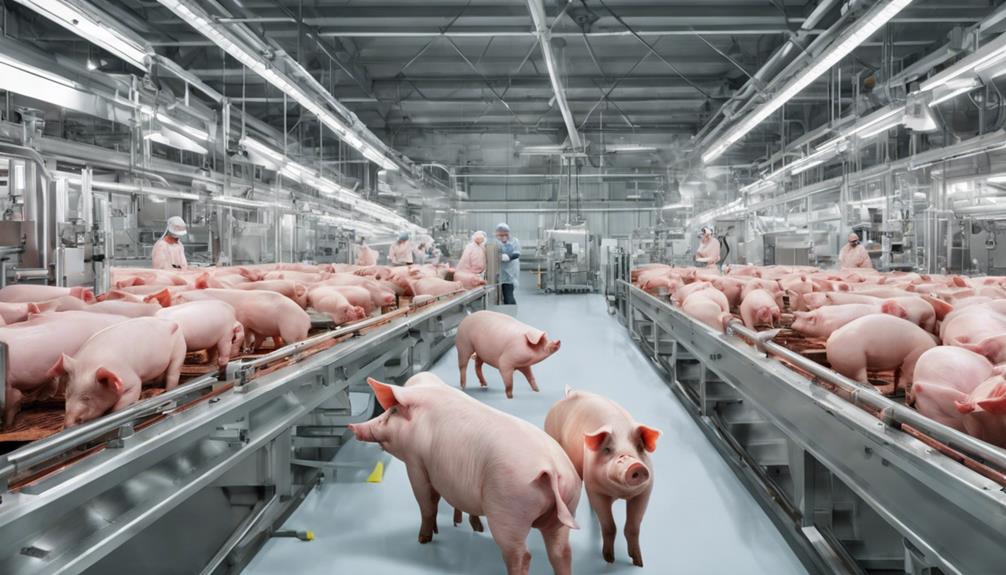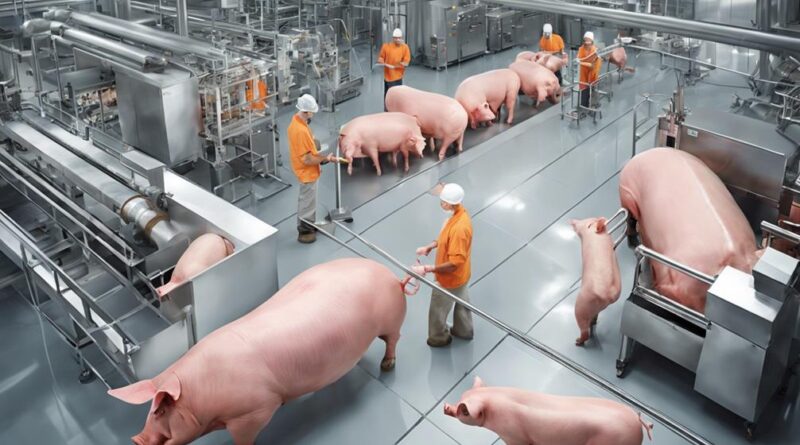How Pig By-products Benefit the Manufacturing Sector
You've probably heard the saying, 'waste not, want not.' Well, when it comes to pig by-products and the manufacturing sector, this couldn't be more true.
The utilization of pig by-products in manufacturing processes goes beyond mere efficiency. It opens up a world of possibilities that can revolutionize the way industries operate.
From enhancing sustainability to unlocking cost-effective solutions, these by-products have the potential to reshape the manufacturing landscape.
Want to uncover how pig by-products are driving innovation and progress in the manufacturing sector?
Economic Value of Pig By-products
When utilizing pig by-products, you can significantly increase economic value in manufacturing processes. Pig by-products offer a range of industrial applications that can enhance the efficiency and sustainability of various manufacturing operations. By incorporating these by-products into your production processes, you not only reduce waste but also create new revenue streams.
One key aspect of the economic value of pig by-products is their versatility in different industrial applications. For example, pig fat can be used in the production of biodiesel, a renewable and eco-friendly alternative to traditional fossil fuels. This not only helps reduce carbon emissions but also decreases dependence on non-renewable resources, contributing to a more sustainable manufacturing sector.
Additionally, pig skin and bones can be processed to extract collagen, which is widely used in the cosmetics and pharmaceutical industries. This extraction process not only adds value to these by-products but also provides essential raw materials for various high-demand products. By tapping into these diverse industrial applications, you can optimize your manufacturing processes and generate additional income from resources that would otherwise go to waste.
Versatility in Manufacturing Processes
To maximize the benefits of pig by-products in manufacturing, it's essential to recognize their versatility in enhancing various production processes. Pig by-products offer innovative solutions and creative applications that can revolutionize how manufacturing operations are carried out. These versatile materials can be utilized in a multitude of ways, from enhancing the durability of products to improving manufacturing efficiency.
One of the innovative solutions that pig by-products provide is their use in developing sustainable packaging materials. By incorporating pig-derived elements into packaging solutions, manufacturers can reduce their environmental impact while maintaining product quality. This creative application not only benefits the environment but also appeals to environmentally conscious consumers.
Moreover, pig by-products can be processed into adhesives and coatings, offering manufacturers a sustainable alternative to traditional petroleum-based options. These innovative solutions not only contribute to reducing carbon footprints but also provide a cost-effective way to enhance product performance.
In the realm of textile manufacturing, pig by-products are increasingly being used to develop eco-friendly fabrics with unique properties. By leveraging these materials in creative applications, manufacturers can cater to a growing market demand for sustainable and high-quality textiles.
Sustainable Sourcing Practices
Considering the environmental impact of manufacturing, implementing sustainable sourcing practices for pig by-products is crucial for promoting eco-friendly production methods. When it comes to sourcing pig by-products, there are several key strategies that can help reduce waste and optimize resources effectively:
- Collaborating with Local Farms: By sourcing pig by-products from local farms, you can reduce transportation emissions and support the local economy.
- Implementing Circular Economy Practices: Adopting circular economy principles allows for the reuse and recycling of pig by-products, minimizing waste and maximizing resource efficiency.
- Exploring Innovative Technologies: Investing in innovative technologies such as biorefining can help extract maximum value from pig by-products while reducing environmental impact.
- Ensuring Ethical Treatment: Prioritizing ethical treatment of animals not only aligns with sustainable practices but also enhances the overall reputation of the manufacturing process.
- Monitoring Supply Chain Transparency: Maintaining transparency throughout the supply chain ensures that sourcing practices are environmentally responsible and sustainable.
Enhancing Productivity and Efficiency
To optimize manufacturing output and streamline operations, enhancing productivity and efficiency is essential in utilizing pig by-products effectively. By incorporating pig by-products into your manufacturing processes, you can significantly increase output without compromising on quality. These by-products, such as fats and proteins, can be utilized in various ways to enhance the efficiency of your operations.
One way pig by-products can help in increasing output is by serving as cost-effective alternatives to traditional materials. For instance, using pig fats in the production of biodiesel can lower costs while maintaining the same level of productivity. Additionally, pig proteins can be used in animal feed production, ensuring that resources are utilized efficiently and output is maximized.
Streamlining operations through the integration of pig by-products can also lead to significant efficiency gains. By repurposing these by-products instead of disposing of them as waste, you not only reduce environmental impact but also optimize resource utilization. This can result in smoother production processes and reduced downtime, ultimately boosting overall productivity.
Diverse Applications in Different Industries
Numerous industries benefit from the diverse applications of pig by-products, showcasing their versatility and value in different manufacturing sectors. Pig by-products are utilized in various industries, each harnessing their unique properties for specific applications.
Here are some key areas where pig by-products find extensive use:
- Food industry: Pig by-products play a crucial role in the food sector, where they're utilized in the production of items such as gelatin, flavor enhancers, and even certain food additives.
- Pharmaceutical applications: In the pharmaceutical industry, pig by-products are valuable in the production of medications, capsules, and even certain vaccines due to their biocompatibility and functional properties.
- Cosmetics manufacturing: Pig by-products are also utilized in the cosmetics industry for producing items such as makeup, creams, and lotions, benefiting from their emollient and binding properties.
- Leather goods production: The leather industry extensively uses pig hides for creating a variety of products such as shoes, bags, and garments, owing to their durability and texture.
- Biofuel production: Pig fat is utilized in the biofuel sector for generating biodiesel, contributing to sustainable energy practices and reducing reliance on fossil fuels.
These diverse applications highlight the significant role pig by-products play across various industries, underscoring their importance and value in manufacturing processes.
Cost-Effectiveness in Production
Utilizing pig by-products in manufacturing processes offers a cost-effective solution for various industries seeking efficient production methods. By incorporating pig-derived materials into manufacturing, businesses can achieve significant cost savings. Pig by-products provide a cost-effective alternative to traditional raw materials, enabling companies to reduce their production expenses while maintaining the quality of their end products.
One key advantage of using pig by-products is resource utilization. These materials, which were previously considered waste, are now being repurposed to create valuable inputs for manufacturing. By utilizing pig-derived resources, industries can make the most out of every part of the animal, minimizing waste and maximizing efficiency in production processes. This resource utilization not only contributes to cost savings but also aligns with sustainable practices, making it a win-win solution for both businesses and the environment.
Incorporating pig by-products into manufacturing operations can lead to a more streamlined and cost-effective production process. By leveraging these materials effectively, industries can enhance their competitiveness in the market while also promoting resource sustainability. Through strategic resource utilization and a focus on cost savings, businesses can optimize their production methods and pave the way for a more efficient and environmentally conscious manufacturing sector.
Environmental Benefits of Pig By-products

Incorporating pig by-products into manufacturing not only yields cost savings but also offers significant environmental benefits. When you utilize pig by-products in your manufacturing processes, you're actively contributing to reducing waste and promoting sustainability.
Here are some key environmental benefits of incorporating pig by-products:
- Reduces Landfill Waste: By using pig by-products, you're diverting these materials from ending up in landfills, reducing the environmental impact of waste disposal.
- Energy Efficiency: Pig by-products can be converted into energy sources such as biogas or biofuels, providing a renewable and sustainable energy alternative.
- Conserves Resources: Utilizing pig by-products helps in conserving raw materials that would have otherwise been used, promoting a more efficient use of resources.
- Decreases Pollution: The incorporation of pig by-products can lead to a reduction in pollution levels, as these materials can often be processed in environmentally friendly ways.
- Enhances Ecosystem Health: By reducing waste and promoting sustainability through the use of pig by-products, you contribute to a healthier ecosystem by minimizing the environmental impact of manufacturing processes.
Compliance With Industry Regulations
How can adherence to industry regulations benefit your utilization of pig by-products in manufacturing processes? Regulatory requirements play a crucial role in ensuring that the use of pig by-products meets specific standards for safety, quality control, and ethical considerations. By complying with these regulations, you not only demonstrate a commitment to operating within legal frameworks but also gain the trust of consumers and stakeholders. Ethical considerations, such as proper handling and disposal of by-products, are key aspects that can enhance your company's reputation and sustainability practices.
Quality control is another vital factor influenced by regulatory requirements. Meeting industry standards guarantees that the pig by-products used in manufacturing processes are of high quality, free from contaminants, and safe for use. This adherence not only safeguards your final products but also ensures consistency and reliability in your manufacturing operations. Additionally, understanding and complying with market demand regulations enable you to align your production processes with consumer preferences and expectations.
Frequently Asked Questions
How Do Pig By-Products Compare to Other Animal By-Products in Terms of Economic Value?
When it comes to economic value, pig by-products stand out in the market demand compared to other animal by-products. Their versatility and high demand make them economically valuable. Pig by-products are utilized efficiently, reducing waste and environmental impact while maximizing resource utilization.
This economic comparison highlights the significant role that pig by-products play in various industries, showcasing their importance in driving economic growth and sustainability.
Are There Any Limitations to the Versatility of Pig By-Products in Manufacturing Processes?
When considering the use of pig by-products in manufacturing, limitations exist that may impact their versatility. Regulatory compliance and environmental impact are potential challenges that need to be addressed.
Drawbacks such as varying quality and sourcing issues can also affect their suitability for certain processes. Despite these limitations, proper management and innovation can help mitigate these challenges and maximize the benefits of pig by-products in manufacturing.
What Specific Sustainable Sourcing Practices Are Used to Ensure the Quality of Pig By-Products?
When it comes to sustainable sourcing practices for pig by-products, ensuring quality is key. Implementing rigorous quality assurance measures is crucial in maintaining the integrity of these materials.
Can Using Pig By-Products Actually Enhance Productivity and Efficiency in Manufacturing?
Using pig by-products can indeed enhance efficiency and economic value in manufacturing. These materials can be repurposed in various ways to optimize production processes and reduce waste.
Are There Any Industries That Do Not Benefit From the Diverse Applications of Pig By-Products?
In many industries, the diverse applications of pig by-products have proven beneficial. However, some sectors may not fully benefit due to environmental impact and ethical concerns surrounding the use of these materials.
Market demand and technological advancements play a crucial role in determining the extent to which pig by-products can be effectively utilized across different industries.
It's essential to consider these factors when assessing the potential limitations of incorporating pig by-products.
Conclusion
In conclusion, utilizing pig by-products in the manufacturing sector offers numerous economic, environmental, and practical benefits. From enhancing productivity to ensuring compliance with regulations, these versatile materials play a crucial role in various industries.
By harnessing the potential of pig by-products, businesses can improve their sustainability practices, reduce waste, and create cost-effective solutions. Embracing these resources not only boosts efficiency but also contributes to a more sustainable and responsible approach to production.
